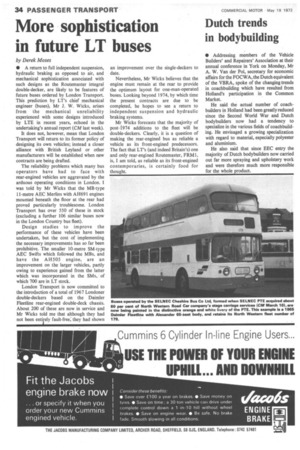More sophistication in future LT buses
Page 36

If you've noticed an error in this article please click here to report it so we can fix it.
by Derek Moses • A return to full independent suspension, hydraulic braking as opposed to air, and mechanical sophistication associated with such designs as the Routemaster integral double-decker, are likely to be features of future buses ordered by London Transport. This prediction by LT's chief mechanical engineer (buses), Mr J. W. Wicks, arises from the mechanical unreliability experienced with some designs introduced by LTE in recent years, echoed in the undertaking's annual report (CM last week).
It does not, however, mean that London Transport will return to its former policy of designing its own vehicles; instead a closer alliance with British Leyland or other manufacturers will be established when new contracts are being drafted.
The reliability problems which many bus operators have had to face with rear-engined vehicles are aggravated by the arduous operating conditions in London. I was told by Mr Wicks that the MB-type 11-metre AEC Merlins with AH691 engines mounted beneath the floor at the rear had proved particularly troublesome. London Transport has over 550 of these in stock (excluding a further 106 similar buses now in the London Country bus fleet).
Design studies to improve the performance of these vehicles have been undertaken, but the cost of implementing the necessary improvements has so far been prohibitive. The smaller 10-metre SM-type AEC Swifts which followed the MBs, and have the AH505 engine, are an improvement on the larger vehicles, partly owing to experience gained from the tatter which was incorporated in the SMs, of which 700 are in LT stock.
London Transport is now committed to the introduction of a total of 1967 Londoner double-deckers based on the Daimler Fleetline rear-engined double-deck chassis. About 200 of these are now in service and Mr Wicks told me that although they had not been entirely fault-free; they had shown an improvement over the single-deckers to date.
Nevertheless, Mr Wicks believes that the engine must remain at the rear to provide the optimum layout for one-man-operated buses. Looking beyond 1974, by which time the present contracts are due to be completed, he hopes to see a return to independent suspension and hydraulic braking systems.
Mr Wicks forecasts that the majority of post-1974 additions to the fleet will be double-deckers. Clearly, it is a question of making the rear-engined bus as reliable a vehicle as its front-engined predecessors. The fact that LT's (and indeed Britain's) one and only rear-engined Routemaster, FRM1, is, I am told, as reliable as its front-engined contemporaries, is certainly food for thought.




























































































































